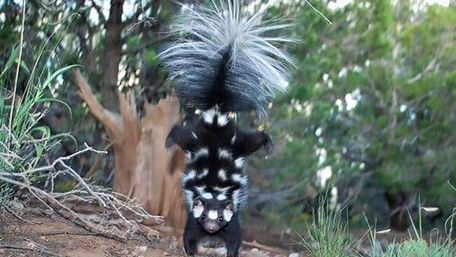The Western Spotted Skunk

IS THIS POSE A HALLOWEEN “TRICK”? OR A “TREAT”?
Actually… it’s neither. This trademark “handstand” is part of the threat display exhibited by the Western Spotted Skunk (Spilogale gracilis).
Spotted skunks are the smallest, quickest, most agile, and most carnivorous of North America’s skunks. Their range includes all of the western United States, northern Mexico, and southern British Columbia, where they inhabit rocky bluffs and canyon stream beds with lots of brush for cover.
We seldom smell, and even more seldom see, the spotted skunks in Clark County Wetlands Park. They are nocturnal omnivores, searching for their meals of eggs, mice, voles, roots, fruit, berries, beetles, grasshoppers, small birds, scorpions, and carrion under cover of darkness, when Park visitors are home in their beds.
These skunks are great examples, as Melvin R. Ellis writes in Wild Animals of North America, of “an example of how to live in peace by being perpetually prepared for massive retaliation….” Nobody wants a dose of the sulfurous, foul-smelling yellowish musk produced by a skunk’s anal glands when it is disturbed!
A threatened spotted skunk raises its tail, stamps its fore-feet, hisses, and scratches the ground before raising its hindquarters into the air in a “handstand,” fluffing out its tail to show off its conspicuous black-and-white warning colors. Only if the enemy presses its attack will the skunk lower its hindquarters, bend around to show both its head and tail, level off, and spray! Skunks can aim with great accuracy at up to ten feet, generally targeting the enemy’s eyes.
Spotted skunks usually make their dens in rocky outcrops or hollow logs but may also live peacefully near people for years under building foundations, in rock fences, or even in attics without being detected. They can be good farm or ranch partners, killing rats, mice, and insects in fields and outbuildings.
Skunks were among our wild neighbors at my parents’ property in southeast Las Vegas in the late 1960’s and 1970’s. The “spotted” that showed up under the car in our garage one morning was likely a long-term “silent partner” at the stable. We were never sure how he ended up in there, but he hissed vigorously and stamped his feet at our curious dogs as soon as we rolled the garage door up.
You never saw dogs get corralled into a back yard so fast! Our wiser cats had already beaten a hasty retreat. By the time we had fed the horses, “Mr. Spots” had gone quietly on his way, without so much as leaving a whiff of spray!
Please enjoy these YouTube videos! Happy Halloween!
Spotted Skunk threat display and spraying
Spotted Skunk eating insects in yard
– By Chris Leavitt, President; photo by Jerry W. Dragoo, Ph.D
